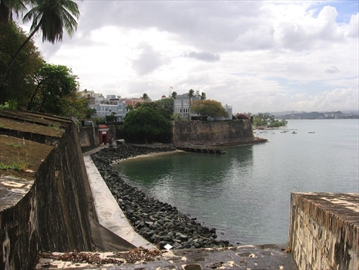“One’s destination,” said the 20th century’s most controversial novelist, Henry Miller — who was also a great traveller — “is never a place, but a new way of seeing things.”
He might well have been thinking of a jewelled old city I’ve returned to so many times I’ve lost track of the number: San Juan, or more accurately, the historic walled Old San Juan of Puerto Rico. It’s existed a very long time — since the 1490s when Christopher Columbus first spied it from sea and claimed it for Spain. It was Spain’s for over four centuries.
The old streets and timeless cliffs still speak of the Old World, a chapter no thoughtful person ever wants to discard. You’ll sense why in Old San Juan’s encircling high grey wall, about three miles long, and the massive stones of Fort San Christobel, and El Morro, both on the northeast headland, erected to protect the then Spanish discovery for centuries. Its old-tense historic nature is revealed in the great city wall, some sections 25-feet thick. Today on Sunday afternoons the green swath of land in front of the fortresses is transformed to a friendly family site as scores of parents and children fly their kites in winds that sweep the stark seaside cliffs.
When I first went to Old San Juan in the late 1970s, I stayed at a hotel, El Convento, that retained the past in every hallway and room. It had been a convent back in the 1600s, a home for nuns, so that its atmosphere had a hushed almost sombre atmosphere of Spanish Catholicism in the New World. The man who had so much to do with its faithful restoration — Ricardo Alegria, an anthropologist with a Harvard doctorate — became a friend so that whenever I returned he was there to help me with Old San Juan’s history. I stayed at El Convento often but when its atmosphere changed, (becoming much more commercial) I moved to a historic inn set near the fortresses, high over the broad sweep of the sea.
The inn, still there, is The Galleria. It was opened by Puerto Rico’s best known artist, Jan D’ Esopo, who became our friend, so that along with its gallery and magnificent views of the seascape, I found my visits, often with Barbara, were almost a return to home. (In fact I once became the greeter at the door for a visiting corporate reception and Barbara a very appealing server at dinner.)
Few small cities — Old San Juan is just seven blocks with a population estimated at a few thousand — can match it for scenic walks and magnificent views. One of my first walks — which I repeated often on subsequent visits — began in a wide promenade in the heart of the old city. It’s Paseo de La Princesa, with waving palms and restful benches. I was heading for the most popular walk, along the city wall, a wall that back then virtually circled the city. To my left I looked out on the endless sweep of blue sea; to my right was the enormous stone wall put there centuries ago, mostly by slave labour, to protect the city should invaders appear on the horizon. In about a half-hour, above the wall, I stood looking at Casa Blanca, one of the jewels of Puerto Rican history: built for the ancestral home of Ponce de Leon, San Juan’s first governor, who was appointed in the early 1500s. (It’s now a museum with artifacts of the 16th and 17th century.) The tropical gardens beside it are lush and unforgettable: especially the dozen varieties of tropical palms, and well-placed sweet hibiscus. Today, you will also see the mansion La Fortaleza that’s home to the current governor, Alejandro Garcia Padilla, a lawyer and Democrat. In time — about two hours after I began my walk — I ended at El Morro, the most dramatic of all historic sites in Puerto Rico with its centuries-old cannons still pointing out to the seas as if invaders might rise on the horizon even now.
Over the years I’ve always remembered a meeting I had on one visit with the fort’s superintendent, then a man named Luis Garcia. He had served the federal parks department elsewhere in the United States, but as if he knew it all along, he eventually came home to Old San Juan as the senior official of the fort. That day he told me something that has stayed with me over the years: “We who are Puerto Rican, and who work at the historic sites, see it as more than a job. We are taking care of our patrimony. It is not just for ourselves that we do this, but for others. We are taking care of part of the world’s heritage.” For that vision, all of us who go to Old San Juan should be grateful.
For information on all aspects of travel to Puerto Rico and accommodation, dial toll free: 1-800-981-7575.

